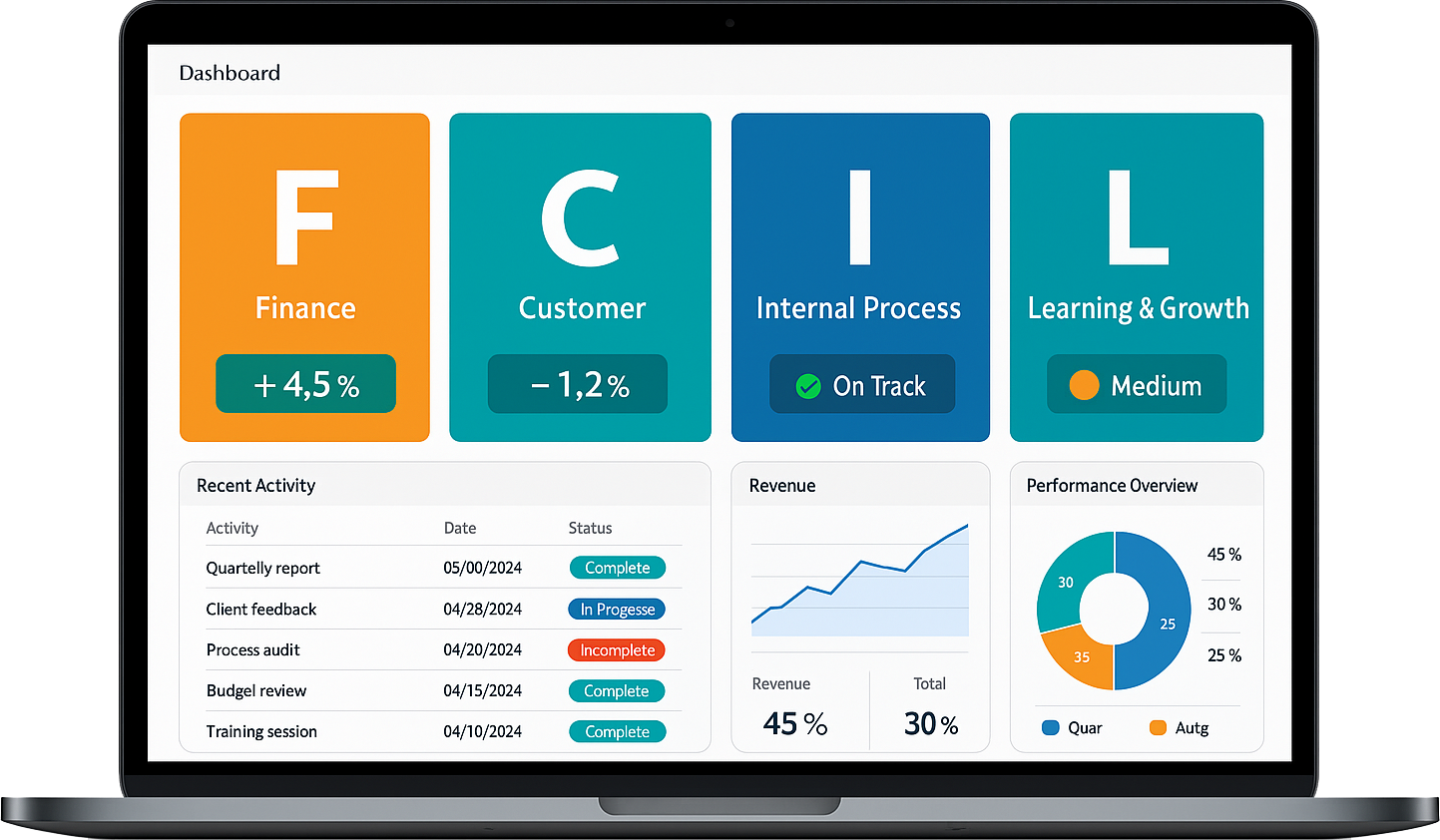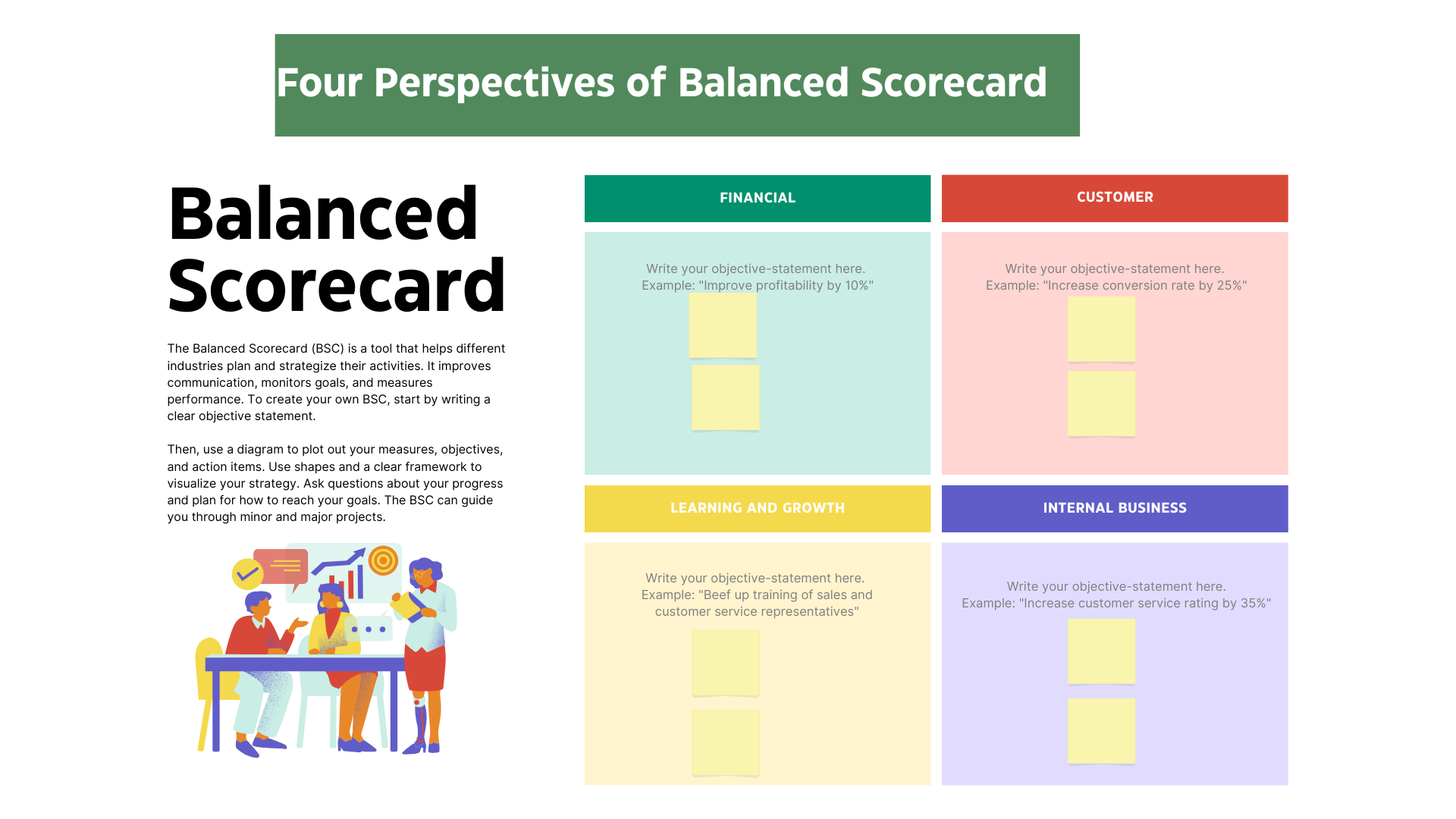The Balanced Scorecard(BSC)) is a strategic management framework developed by Robert Kaplan and David Norton in the early 1990s. It helps organizations translate their vision and strategy into actionable objectives and measurable performance indicators. By incorporating financial and non-financial metrics, the BSC provides a more holistic view of organizational performance.

Here’s an in-depth look at how organizations benefit from implementing a Balanced Scorecard.
1. Holistic Performance Measurement
One of the primary benefits of the Balanced Scorecard(BSC) is its ability to provide a comprehensive view of performance. Traditional performance measurement systems often focus solely on financial metrics, such as revenue and profit margins. However, the BSC includes three additional perspectives: Customer, Internal Processes, and Learning & Growth. This multifaceted approach allows organizations to assess their performance more accurately and understand how different areas contribute to overall success.
- Financial Perspective: Evaluates how well the organization is performing financially and whether its strategy is contributing to the bottom line.
- Customer Perspective: Measures customer satisfaction and retention, emphasizing the importance of customer relationships.
- Internal Processes Perspective: Focuses on the efficiency and effectiveness of internal operations, helping identify areas for improvement.
- Learning & Growth Perspective: Assesses organizational learning, employee engagement, and innovation, ensuring long-term sustainability.
2. Strategic Alignment
The BSC plays a crucial role in aligning business activities with the organization’s strategic objectives. By clearly defining and communicating these objectives, the BSC ensures that all employees understand their roles in achieving the overall strategy. This alignment fosters collaboration among departments, minimizing silos and enhancing cross-functional teamwork.
For example, if an organization aims to improve customer satisfaction, all departments—from marketing to production—can align their efforts towards this goal. The BSC creates a shared understanding of priorities, enabling teams to work together effectively to achieve common objectives.
3. Enhanced Decision-Making
Data-driven decision-making is essential for effective management, and the Balanced Scorecard(BSC) facilitates this by providing relevant performance metrics. Managers can analyze data from multiple perspectives to identify trends and insights that inform strategic decisions. This evidence-based approach reduces reliance on intuition or guesswork, leading to more accurate and timely decisions.
For instance, if customer feedback indicates dissatisfaction with a particular product, the BSC can help managers quickly identify the underlying issues—whether they relate to production quality, delivery times, or customer service. By addressing these issues promptly, organizations can enhance customer satisfaction and loyalty.
4. Improved Communication
The Balanced Scorecard(BSC) promotes clear communication of organizational goals and performance metrics throughout the organization. By providing a framework that articulates the relationship between strategic objectives and performance indicators, the BSC ensures that everyone is on the same page.
Regular updates on progress towards strategic goals foster transparency and engagement among employees. When employees understand how their contributions impact organizational success, they are more likely to feel motivated and committed to their work. This open communication also encourages feedback and dialogue, helping to identify areas for improvement.
5. Focus on Key Performance Indicators (KPIs)
The Balanced Scorecard(BSC) emphasizes the identification and tracking of relevant Key Performance Indicators (KPIs) that reflect strategic objectives. By focusing on a select set of KPIs, organizations can concentrate their efforts on what truly matters for success.
Choosing the right KPIs is crucial; they should be specific, measurable, attainable, relevant, and time-bound (SMART). For example, if a company’s strategic objective is to increase market share, relevant KPIs could include customer acquisition rates, market penetration rates, and customer retention rates.
6. Increased Accountability
The BSC fosters accountability within the organization by clearly defining objectives and performance measures. Each department and individual is aware of their responsibilities and how their performance impacts overall goals. This clarity encourages a culture of ownership and responsibility.
Regular performance reviews based on BSC metrics help hold teams accountable for their contributions. When employees see the direct link between their efforts and organizational success, they are more likely to take initiative and strive for excellence.

7. Continuous Improvement
A key feature of the BSC is its emphasis on continuous improvement. By regularly reviewing performance metrics and strategic objectives, organizations can identify areas for enhancement and adapt to changing market conditions.
The BSC encourages a proactive approach to performance management. Rather than waiting for annual reviews, organizations can continuously monitor their progress and make adjustments as necessary. This agile mindset allows organizations to stay competitive and responsive to new challenges and opportunities.
8. Enhanced Strategic Planning
The Balanced Scorecard(BSC) provides a structured framework for effective strategic planning. By integrating performance measurement with strategic objectives, organizations can develop actionable plans that drive progress.
During the strategic planning process, organizations can use the BSC to identify gaps between current performance and desired outcomes. This analysis informs the development of specific initiatives and action plans to address these gaps, ensuring that strategies are not only well-defined but also executable.
9. Customer Focus
The Balanced Scorecard(BSC) emphasizes the importance of the customer perspective, helping organizations better understand and meet customer needs. By incorporating customer satisfaction metrics into performance evaluations, organizations can prioritize customer-centric initiatives.
This focus on the customer fosters a culture of service excellence, encouraging employees to prioritize customer interactions and experiences. As a result, organizations can enhance customer loyalty and drive repeat business, ultimately contributing to long-term success.
10. Long-Term Vision
Finally, the Balanced Scorecard(BSC) helps organizations maintain a long-term vision by linking strategic goals with short-term operational objectives. This alignment ensures that day-to-day activities support broader strategic aims, promoting sustainable growth.
Organizations that adopt the BSC can navigate short-term challenges while keeping their long-term goals in sight. This dual focus enables them to build resilience and adaptability in an ever-changing business environment.
Conclusion
The Balanced Scorecard(BSC) is a powerful strategic management tool that offers numerous benefits to organizations. By providing a comprehensive framework for performance measurement, aligning business activities with strategic objectives, and fostering a culture of accountability and continuous improvement, the Balanced Scorecard(BSC) empowers organizations to achieve their goals and drive long-term success. In today’s competitive landscape, leveraging the insights provided by the Balanced Scorecard can make the difference between thriving and merely surviving.